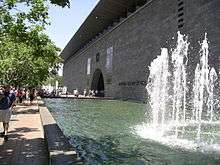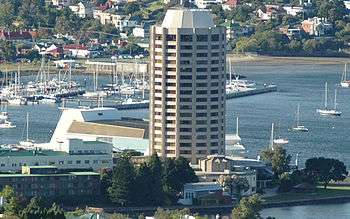Roy Grounds
| Sir Roy Grounds | |
|---|---|
| Born |
18 December 1905 Melbourne, Victoria, Australia |
| Died |
7 March 1981 (aged 75) Melbourne |
| Residence | Australia |
| Nationality | Australian |
| Education | Melbourne University |
| Known for |
National Gallery of Victoria Victorian Arts Centre |
| Scientific career | |
| Fields | Architecture |
Sir Roy Burman Grounds (18 December 1905 – 7 March 1981) was one of Australia's leading architects of the modern movement.
Biography
Born in Melbourne, Grounds was educated at Scotch College and then the University of Melbourne, and worked for the architectural firm of Blackett, Forster and Craig. In 1932 he won an award from the Royal Victorian Institute of Architects (RVIA) and left Melbourne to work in England and the United States for two years, gaining exposure to contemporary architectural developments.
On his return to Australia, Grounds went into partnership with Geoffrey Mewton, and together they designed a number of houses heavily influenced by the new modern movement, especially the simple, rough modernism of US West Coast architect William Wurster. Grounds ended this partnership in 1936 and travelled in England until 1939.
Grounds established his own practice between 1939 and 1942 and designed a series of unusually modern flat developments which further established his reputation. During World War II served in the Royal Australian Air Force, performing works and camouflage duties. After the war, Grounds retired for a few years, returning in 1951 as a senior lecturer at the School of Architecture at Melbourne University. In 1953, he resumed his architectural practice and produced a series of houses, including his own, based pure geometric shapes.
When Grounds, Frederick Romberg and Robin Boyd formed their partnership in 1953 all were well established in Victoria. Each brought substantial work to the practice and the firm became very successful.

Grounds' first large commission was for the Australian Academy of Science in Canberra. The construction of its reinforced concrete dome was a considerable technical achievement. Opened in 1959, it won the Meritorious Architecture Award of the Canberra Area Committee of the Royal Australian Institute of Architects (RAIA) and the Sulman Award for Architectural Merit. The Academy building also led to other work in Canberra, initially for the firm and later Grounds himself. Grounds opened a Canberra office in the Forrest Townhouses (1959), which he partly financed.
In 1959 the firm was awarded the commission to design the National Gallery of Victoria and Arts Centre, with Grounds named in the contract as the architect in charge. When Boyd and Romberg were mildly critical of the preliminary geometric designs that Grounds showed them, relations between the partners became strained, and in 1962 Grounds left the partnership, taking the commission with him and setting up his own company with Oscar Bayne.
Under a building committee chaired by the philanthropist Ken Myer, Grounds devoted the next twenty years of his life to the completion of the Arts Centre. His longest-serving architectural associates throughout this period were Alan Nelson, Fritz Suendermann, Lou Gerhardt and Allan Stillman. While the Gallery was brought in on time and budget, the complicated Yarra River site for the Concert Hall and Theatre Complex resulted in building delays and criticism. Unlike the fate that befell Jørn Utzon on the Sydney Opera House project, Grounds managed to hold on to his commission from the Victorian Government despite tumult within his company in the late 1970s. Grounds showed Queen Elizabeth II the massive excavations shortly before his death. Much of the theatres' interior designs were completed by John Truscott after Grounds' death.
Grounds was awarded the RAIA Gold Medal in 1968 and was knighted in 1969.[1] In 1969 he was elected a life fellow of the RAIA. One of his last designs was Hobart's iconic 18-story octagonal tower and Wrest Point Hotel Casino complex. He died in Melbourne in 1981.
In 2011, with the opening of The Museum of Old and New Art (MONA) in Hobart, Tasmania, two houses designed and built there by Grounds in 1957–9 for Claudio Alcorso on the Moorilla Estate—the Courtyard House and the Round House—became respectively the entrance and the library of Australia's largest private museum.[2]
Key works
- 'The Ship' (Grounds' family house), Mt Eliza (1935)
- Lyncroft, Shoreham (1935)
- Evan Price House, Essendon (1935)
- House, 236 Kooyong Road, Toorak (1935)
- Chateau Tahbilk homestead, Tahbilk (1935)
- Ramsay House, Mt Eliza (1937)
- Clendon Flats, Armadale (1940)
- Moonbria Flats, Toorak (1941)
- Quamby Flats, Toorak (1941)
- Leyser House, Kew (1952)
- Grounds House and flats, Hill Street, Toorak (1953)
- Henty House (Round house), Frankston South (1953)
- Currawong Ski Lodge, Thredbo (1957)[3]
- Moorilla Estate, Hobart (1958–9), now part of The Museum of Old and New Art (MONA, by architects Fender Katsalidis)
- Shine Dome, Australian Academy of Science, Canberra (1959)
- Botany Building Australian National University, Canberra (1968)
- National Gallery of Victoria, St Kilda Road, Melbourne (1959–68)
- Medley Building, Melbourne University (1968-71)
- Robert Blackwood Hall, Monash University, Victoria (1971)
- Swan Hill Pioneer Settlement & Folk Museum expansion, Victoria (early 1970s)
- Wrest Point Hotel Casino, Hobart, Tasmania (1973)
- Myer and Nicholas families homes, Toorak, Melbourne (1970s)
- Arts Centre Melbourne, St Kilda Road, Melbourne (1969–84)
Gallery of works
 Shine Dome, Australian Academy of Science
Shine Dome, Australian Academy of Science National Gallery of Victoria
National Gallery of Victoria Wrest Point Hotel Casino, Hobart, Tasmania
Wrest Point Hotel Casino, Hobart, Tasmania
Awards
- 1959 RAIA Meritorious Architecture Award
- 1959 Sulman Award for Architectural Merit
- 1968 RAIA Gold Medal, Royal Australian Institute of Architects
- 1969 Knighted by Queen Elizabeth II
References
Sources
- Jennifer Taylor, Australian Architecture Since 1960, RAIA, 1990
- Philip Goad, A Guide to Melbourne Architecture, Sydney, 1999
- Geoffrey Serle, Robin Boyd: A Life, Melbourne, 1995
- Eric Westbrook, Birth of a Gallery, Macmillan Australia, Melbourne, 1968